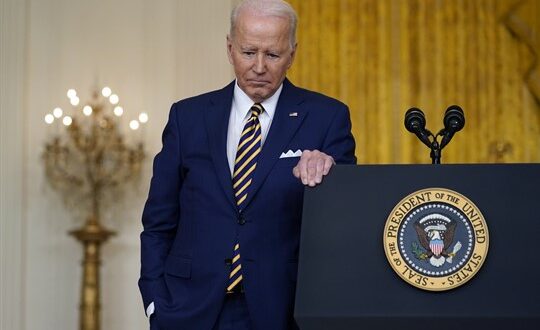Assessing the Biden administration’s performance in the Middle East at the one-year mark requires some careful metrics. Should the benchmark be a comparison to the turbulent Trump years, or to earlier times when U.S. diplomacy was defining the regional agenda and, on occasion, making a meaningful contribution to achieving peace? Should it prioritize the possibility that people in the region, who once resented the effects of too much U.S. power, now fear its absence, or the emerging consensus in Washington that the U.S. has more urgent strategic challenges to attend to elsewhere?
Biden administration officials talk in pragmatic terms about the Middle East, and many observers in the U.S. foreign policy community applaud the effort to set achievable goals, without grandiose ambition. Bret McGurk, the Biden team’s point man on the Middle East who has now served in four presidential administrations, is quick to acknowledge that for decades, the U.S. has overcommitted and overpromised in the region. It is now putting aside the maximalist goals of transforming the Middle East through its largely discredited efforts at regime change or democratization—or, alternatively, its Faustian bargains with authoritarians.
To be sure, many worry that the U.S. is turning its back on the Middle East in its rush to focus on the geopolitical challenges from China and Russia. But U.S. officials are confident that Washington remains the security partner of choice for regional governments. And they have assured partners that as combat operations and the “forever wars” in Iraq and Afghanistan wind down, the U.S. still has the capacity and the will to engage diplomatically, while providing security assistance and military training, to address regional rivalries and the ongoing threats from terrorism. For American diplomats, that means adapting to an evolving landscape where the U.S. no longer seeks to assert primacy in every crisis, and where several regional players—Israel, the United Arab Emirates and Turkey, and perhaps Iraq and Egypt—are showing they are willing and able to set the regional agenda. After a decade in which almost all actors in the Middle East were fanning the flames of cross-border rivalries and conflicts, they are now beginning to engage on the work of solving local problems through diplomatic engagement.
In a Carnegie Endowment webinar yesterday, McGurk, who oversees Middle East policy at the National Security Council, articulated the United States’ core interests in the region as preventing a nuclear Iran, promoting stability and protecting vital waterways—code for shipping routes for oil and international trade. One can debate whether this list is really different than historical versions, in which Israel’s security and the free flow of oil were more explicitly mentioned. But in leaving out the promotion of values like democracy, human rights and human dignity, it suggests those are now on a second tier—important but not vital.
On Iran, the administration is cautiously hopeful about its ongoing negotiations to revive the Joint Comprehensive Plan of Action, or JCPOA. Recent reports from Vienna of dissent within the U.S. delegation notwithstanding, the administration knows that to restore the agreement will require both firmness and flexibility, and it is well aware of the political costs of appearing to be soft on Iran. Nevertheless, it places highest priority on the threat from Iran’s nuclear program, which has worsened due to the Trump administration’s “maximum pressure” campaign and withdrawal from the JCPOA.
Although Biden has achieved no major achievements or diplomatic breakthroughs in his first year in office, that would be using the wrong yardstick to judge his Middle East record so far.Regional countries have long complained that Washington has not paid enough attention to Iran’s political and military activities in Lebanon, Yemen, Syria and beyond. But there’s no sign of an appetite for biting off an even bigger challenge, what used to be called the “grand bargain” approach to Iran. For now, the Biden team’s pragmatic instincts are focused on achievable steps, and they would likely accept something even short of a new and improved JCPOA, as long as it opened a path to reimposing some restraints on Iran’s nuclear activities.
Relations with Israel and the Gulf states are often focused on Iran, but Biden—ironically, like his predecessor, Donald Trump—is wary of promising too much. While the threat of military force is still ostensibly on the table, regional actors are deeply aware of Biden’s reluctance to contemplate a war to destroy Iran’s nuclear program. Diplomats still speak of “all options” being on the table, but Biden’s preference for restraint is well understood, and that has nudged regional governments to engage Tehran.
More broadly, Washington’s security partnerships in the Middle East remain strong. The U.S. is not shutting down any of its military bases in the region, even if their operational tempo has slowed and total troop numbers may be quietly reduced. So the net effect is a sense of continuity, not a rush for the exit. But governments and regional publics are pressing Washington for more assurances, adding to the general impression of a foreign policy that is less robust than many anticipated.
The administration’s desire to set more realistic expectations also extends to Syria and Yemen. Syria is currently the only place where American military force is still being used, including recent air support to the Syrian Kurdish forces’ operation to turn back an Islamic State assault on a prison facility in Hasakah. Since tactical anti-terrorist operations are the core mission of U.S. forces in Syria, this latest show of force is consistent with the well-established protocols for countering ISIS or al-Qaida in the area, rather than a reflection of any new policy decisions. But in the larger context of the Syrian conflict, the administration has not asserted itself in the complicated dynamics among the external actors—Turkey, Iran and Russia—and seems resigned to managing what is an unfavorable status quo.
Policy on Yemen has been driven primarily by the country’s acute humanitarian crisis, and the administration seems to have stalled out on its campaign to press Saudi Arabia and the UAE to end the war there. Rather, it blames the Houthis for the latest escalation in fighting and quickly offered the UAE political and military support after two drone and missile attacks on its territory last week. In the aftermath of those attacks, one of which targeted the Al Dhafra airbase where U.S. forces are stationed, the Biden administration may acquiesce to UAE pressure to restore the Houthis to the State Department’s terrorist list, after having reversed that Trump policy in order to facilitate delivering aid to the desperate Yemeni people. The administration also sent its special envoy for Yemen to show support for United Nations diplomacy to end the war, but in reality, the Biden team has reverted to quiet diplomatic engagement, rather than the public posturing of Biden’s 2020 presidential campaign rhetoric.
As for Biden’s frequent exhortations about human rights and American values, they have made for thin gruel in his Middle East policy. He has not satisfied progressives in the Democratic Party, or in the region, who hoped for a tougher approach to the deplorable human rights records of the region’s authoritarians, nor has he shown any sign of interest in engaging the Israel-Palestine conflict. That is perhaps justifiable, given both sides’ lack of interest in negotiations, but it falls short of demands among progressive Democratic figures in Congress for greater justice for the Palestinians.
While it’s fair to say that Biden has achieved no major achievements or diplomatic breakthroughs in his first year in office, that would be using the wrong yardstick to judge his record so far. There is at least a process underway to restore the JCPOA, although some would consider the painfully slow negotiations to be a self-inflicted wound. And the lack of progress in Syria and Yemen cannot be considered a uniquely American failure.
On closer examination, the Biden administration spent its early months working to restore trust with allies and partners after the abrupt and disruptively radical shifts in direction over successive U.S. administrations. But that trust is elusive. Many regional partners were tired of Washington’s arrogance and overreliance on military force, but the notion of a more modest set of U.S. goals has been hard to swallow. And the way the U.S. exited Afghanistan exacerbated the problem by raising questions about U.S. competence and credibility.
One thing the Biden administration’s approach to the Middle East makes clear is that the region is no longer the center of gravity for U.S. national security, which may be long overdue. And a better alignment of ends and means is a practical strategy for a sustainable engagement with partners, one that emphasizes joint efforts and a greater reliance on regional powers to deal with threats.
In other words, the Biden team has done some smart thinking to recalibrate U.S. policy to advance its interests. Yet the larger malaise about U.S. power and purpose has cast its shadow. This new Middle East policy is a necessary course correction, but critics at home and abroad may still judge it as disappointing.
 Eurasia Press & News
Eurasia Press & News




